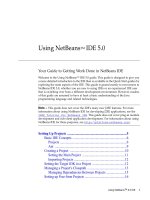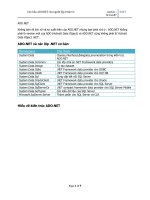Essential .NET Tools
Bạn đang xem bản rút gọn của tài liệu. Xem và tải ngay bản đầy đủ của tài liệu tại đây (66.84 KB, 5 trang )
158
Chapter 5
CHAPTER 5
Essential .NET Tools
The .NET Framework SDK contains many useful programming tools. Here,
in an alphabetical list, are those we have found most useful or necessary for
developing C# applications. Unless otherwise noted, the tools in this list
can be found either in the \bin directory of your .NET Framework SDK
installation or in the %SystemRoot%\Microsoft.NET\Framework\VERSION
directory (replace VERSION with the framework version). Once the .NET
Framework is installed, you can access these tools from any directory. To
use any of these tools, invoke a Command Prompt window and enter the
name of the desired tool. For a complete list of the available command-line
switches for any given tool, enter the tool name (e.g.,
csc
) and press the
Return or Enter key.
ADepends.exe: assembly dependency list
Adepends displays all assemblies that a given assembly is dependent on to
load. This is a useful C# program found among the samples in the \Tool
Developers Guide directory beneath the .NET Framework or Visual Stu-
dio .NET directory tree. You need to install these samples before you can
use them, because they are not installed by default.
Al.exe: assembly linking utility
Creates an assembly manifest from the modules and resources files you
name. You can also include Win32 resources files. Here’s an example:
al /out:c.dll a.netmodule b.netmodule
CorDbg.exe: runtime debugger
General source-level, command-line debug utility for MSIL programs.
Very useful tool for C# source debugging. Source for cordbg is available
in the \Tool Developers Guide directory.
Csc.exe: C# compiler
Compiles C# sources and incorporates resource files and separately
compiled modules. Also allows you to specify conditional compilation
,ch05.24722 Page 158 Wednesday, February 13, 2002 5:21 PM
Essential .NET Tools
|
159
options, XML documentation, and path information. Here are some
examples:
csc foo.cs /r:bar.dll /win32res:foo.res
csc foo.cs /debug /define:TEMP
DbgClr.exe: GUI debugger
Windows-based, source-level debugger. Available in the \GuiDebug
directory of the .NET Framework SDK installation.
GACUtil.exe: global assembly cache utility
Allows you to install, uninstall, and list the contents of the global
assembly cache. Here’s an example:
gacutil /i c.dll
ILAsm.exe: MSIL assembler
Creates MSIL modules and assemblies directly from an MSIL textual
representation.
ILDasm.exe: MSIL disassembler
Disassembles modules and assemblies. The default is to display a tree-
style representation, but you can also specify an output file. Here are
some examples:
ildasm b.dll
ildasm b.dll /out=b.asm
InstallUtil.exe: installer utility
Executes installers and uninstallers contained within the assembly. A
logfile can be written, and state information can be persisted.
Ngen.exe: native image generator
Compiles an assembly to native code and installs a native image in the
local assembly cache. That native image is used each time you access the
original assembly, even though the original assembly contains MSIL. If
the runtime can’t locate the native image, it falls back on JIT compila-
tion. Here are some examples:
ngen foo.exe
ngen foo.dll
nmake.exe: make utility
Common utility that scripts building of multiple components and
source files and tracks rebuild dependency information. See Appendix E
for more information.
PEVerify.exe: portable executable verifier
Verifies that your compiler has generated type-safe MSIL. C# will always
generate type-safe MSIL. Useful interop with ILASM-based programs.
,ch05.24722 Page 159 Wednesday, February 13, 2002 5:21 PM
160
|
Chapter 5: Essential .NET Tools
RegAsm.exe: register assembly tool
Registers an assembly in the system registry. This allows COM clients to
call managed methods. You can also use it to generate the registry file
for future registration. Here’s an example:
regasm /regfile:c.reg c.dll
RegSvcs.exe: register services utility
Registers an assembly to COM+ 1.0, and installs its typelib into an
existing application. Can also generate a typelib. Here’s an example:
regsvcs foo.dll /appname:comapp /tlb:newfoo.tlb
Sn.exe: shared name utility
Verifies assemblies and their key information. Also generates key files.
Here’s an example:
sn -k mykey.snk
SoapSuds.exe: SoapSuds utility
Creates XML schemas for services in an assembly and creates assem-
blies from a schema. You can also reference the schema via its URL.
Here’s an example:
soapsuds
–url:http://localhost/myapp/app.soap?wsdl
–os:app.xml
TlbExp.exe: type library exporter
Exports a COM typelibderived from the public types within the sup-
plied assembly. Differs from regasm in that it doesn’t perform any regis-
tration. Here’s an example:
tlbexp /out:c.tlb c.dll
TlbImp.exe: type library importer
Creates a managed assembly from the supplied COM typelib, mapping
the type definitions to .NET types. You need to import this new assem-
bly into your C# program for use. Here’s an example:
tlbimp /out:MyOldCom.dll MyCom.tlb
Wsdl.exe: web services description language tool
Creates service descriptions and generates proxies for ASP.NET web-
service methods. See the ASP.NET documentation in the .NET Frame-
work SDK for more detail on web services.
WinCV.exe: windows class viewer
Searches for matching names within a supplied assembly. If none are
supplied, it uses the default libraries. The namespaces and classes are
displayed in a listbox, and the selected type information is displayed in
another window.
,ch05.24722 Page 160 Wednesday, February 13, 2002 5:21 PM
Essential .NET Tools
|
161
Xsd.exe: XML schema definition tool
Generates XML schemas from XDR, XML files, or class information.
Can also generate DataSet or class information from a schema. Here’s
an example:
xsd foo.xdr
xsd bar.dll
,ch05.24722 Page 161 Wednesday, February 13, 2002 5:21 PM
,ch05.24722 Page 162 Wednesday, February 13, 2002 5:21 PM









